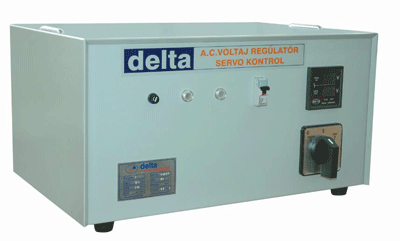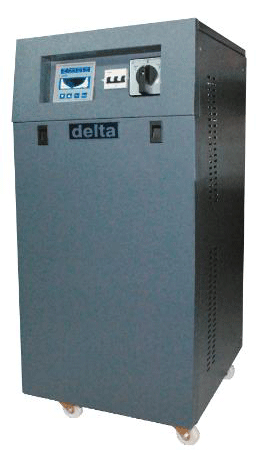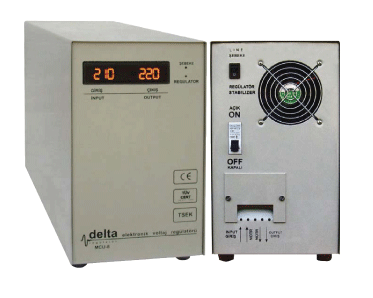 A voltage regulator is basically an electrical regulator meant for automatically maintaining a constant voltage level. The regulator makes use of either an electromechanical mechanism or some active or passive electronic components. The design of the device decides whether it should be used to control AC or DC voltages.
GENSER can provide you the full detailed specifications, offer free site surveys and can provide you all the ancillary equipment your voltage regulators installation will require.
We offer a cost efficient and reliable way to ensure a stable mains supply for mission critical / sensitive applications.
We offer the Automatic Voltage Regulators with outstanding reliability of servo-mechanical and solid state Line Voltage Regulator designs that are on duty throughout the world - facing some of the most rigorous and demanding environments. We offer Voltage Regulator manufactures which are backed by the unrivalled experience have gained in world markets over the last 25 years or so. There are different types of voltage regulators used for various applications including: A voltage regulator is basically an electrical regulator meant for automatically maintaining a constant voltage level. The regulator makes use of either an electromechanical mechanism or some active or passive electronic components. The design of the device decides whether it should be used to control AC or DC voltages.
GENSER can provide you the full detailed specifications, offer free site surveys and can provide you all the ancillary equipment your voltage regulators installation will require.
We offer a cost efficient and reliable way to ensure a stable mains supply for mission critical / sensitive applications.
We offer the Automatic Voltage Regulators with outstanding reliability of servo-mechanical and solid state Line Voltage Regulator designs that are on duty throughout the world - facing some of the most rigorous and demanding environments. We offer Voltage Regulator manufactures which are backed by the unrivalled experience have gained in world markets over the last 25 years or so. There are different types of voltage regulators used for various applications including:

- Automatic Voltage Regulator .
- Combination or Hybrid Regulators.
- Contact Voltage Regulator.
- Fixed Voltage Regulator.
- Fully Automatic AC Voltage Regulator.
- Linear Regulators.
- Steady Automatic Voltage Regulator.
- Stepless Control Regulator.
Automatic Voltage Regulators
An automatic voltage regulator is an electronic device or circuit that automatically maintains a constant amount of voltage in an electrical line.
- Provides protection against short circuit and overload.
- Offers automatic voltage regulation.
- Protects sensitive electronic equipments against brownouts and over voltages.
- Provides protection against surge, spike and lightning.
- Offers reliable and consistent voltage regulation.
- Automatic voltage regulator are provided with LED indicators to monitor status of working, excitation, sensing voltage, etc.
- Supplied with dual meters that indicate regulated voltage and line voltage.
- They have a modular construction for easy customization.
Uses & Applications
Automatic voltage regulator is used with almost all kinds of electrical and electronic equipments. Some of its common applications include:

- Generators.
- Auto testing equipment.
- Broadcasting.
- Industrial automation.
- Commercial application in high rise buildings.
- Military application.
- Process control.
- Marine application.
- Medical application.
- Mobile communication.
Combination or Hybrid Regulators
Combination or hybrid regulator comprises of more than one regulator connected in series. Many power supplies utilizes more than one regulation method for various purposes. Combining linear and switch-mode regulators is a common technique for generating multiple supply voltages.
Working Principle
To explain the working of a combination regulator, let us consider the combination of switching regulator and a linear regulator. The voltage output from a switching regulator can be again regulated by a linear regulator. In the process, the switching regulator accepts a large range of input voltage and in turn generates a little noisy voltage, which is slightly higher than desired output. This is followed by a linear regulator that produces an exact amount of the desired voltage and almost diminishes all noise produced by the switching regulator. Many such hybrid regulator exists, which are designed combining two different types of regulators.
Uses & Applications

Some of the applications of combination or hybrid regulator includes:
- Automobile industry.
- Battery operating equipments.
- Industrial automation.
- Refrigeration.
- Sensitive electronic devices.
Contact Voltage Regulator
Contact voltage regulator is a special type of voltage regulator that maintains a constant voltage level in various electrical and electronic equipments. These devices have a specific mode of operation.
Working Principle
The device has a coil, which rotates on the loop core along with three brushes colliding with the surface in contact with the coil. This is accomplished with the help of a spring pressure effect. The coil rotates the revolving shaft to activate the brush stand. This results in rotation of the brush along the coil surface to change the contact position of the brush. Altering the turning rate of coil leads to accurate adjustment of the output voltage within a specific range.
Features:
- These regulators have simple and reliable operation.
- There is no waveform distortion.
- Contact voltage regulators are highly efficient and maintains a constant voltage.
- These regulators are usually light weight.
Uses & Applications
There are various applications of the contact voltage regulator. Some of its application areas are:
- Semiconductors.
- Textile Mills.
- Processing units.
- Engineering units.
- Oil industries.
- Paper Mills.
- Rubber Industries.
- Pharmaceutical industries.
Fixed Voltage Regulator
Fixed voltage regulator converts an AC voltage coming from the power transformer into a constant and stable DC voltage, having a very low ripple component. They are widely used for supplying a stable voltage to low-power equipments such as sensors, analog modules, initiators, etc. housed in an electrical cabinet.
The fixed-voltage regulator is provided with an internal diode, which protects it against induction peaks. There is an integrated thermal overload protector, which provides extra protection. The protector disconnects the fixed-voltage regulator in case of an excessive load. A miniature fuse is also supplied to protect the component. All inputs and outputs have double screw connections; and are supplied with a test point. A green LED indicates the appropriate functioning module in the output.
- Back to top -
|